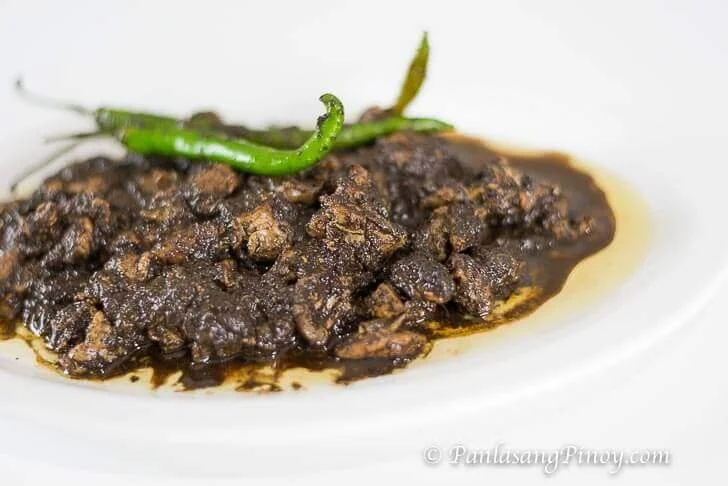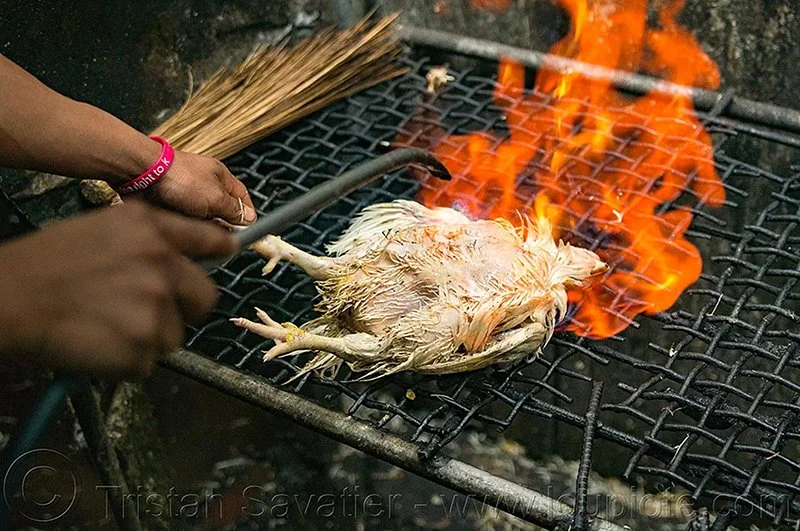Sarap! Tasting Exotic Filipino Dishes
/Filipino cuisine is a gourmand’s paradise, offering a vibrant tapestry of flavors from the Ilocano, Pangasinan, Tagalog, Kapampangan, Bicolano, Visayan, Chavacano, and Maranao culinary traditions. While foreign influences are undeniably present, it’s the indigenous dishes—especially those that diverge from the ordinary—that truly captivate. These distinctive creations are a testament to the Filipino’s inventive and resourceful approach to cooking.
Picking out the best from every province is too daunting, so we narrowed down the choices to the worthiest offerings, from North to South.
Batanes
Uvud is a popular Ivatan dish made from finely grated banana tree pith, mixed with either ground pork, fish, or beef. Locals form the mixture into small balls, which are then cooked with spices and vegetables. The result is a soft, meatball-like delicacy with a subtle taste. Uvud is often cooked in a clear broth or with sautéed vegetables. The banana pith gives it a mild and unique flavor, while the meat adds a savory depth.
Uvud (Source: Batanes Trip)
Vunes is made of preserved gabi (taro) stalks that can last for years. As a typical Batanes food, the gabi stalks are first soaked in water, then cut, minced, and cooked together with pork and patola (sponge gourd). Ground pork, rehydrated dried taro stalks, coconut milk, shallots, and ginger complete the ensemble. Delicious. The unique flavor of gabi blends well with salty meat and fish. Its soft texture makes it filling and satisfying.
Vunes (Source: Batanes Trip)
Ilocandia
Ilocos is known for its heritage sites and natural allure, but the locals are just as proud of their culinary traditions. To them, food is more than just physical nourishment. It connects to their roots and is worth sharing with the world.
Ilocos cuisine boasts of hearty dishes that offer a taste of the past, blending bold and appetizing flavors. From iconic dishes synonymous with Ilocano identity to modern interpretations of the classics, the province’s culinary landscape is as diverse as it is delicious.
Moving from the iconic pinakbet (braised mixed vegetables), the Ilocano’s adventurous palate is reflected in the dish called dinardaraan, a bold rendition of pork blood stew. The main ingredient is intestines chopped and fried crisp, paired with bagnet (crackling pork belly). Fat is rendered from pieces of pork cheek before shallots, ginger, garlic, and chilies are thrown in, followed by fresh pork blood, tamarind juice and fish sauce. Everything is sauteed slowly until softened and highly aromatic. Unbelievably good!
Dinardaraan (Source: Panlasang Pinoy)
Cordillera
Pinikpikan is a chicken or duck dish from the mountains of the Cordillera region. It is prepared by gently beating a live chicken to death with a stick prior to cooking. The beating bruises the chicken's flesh, bringing blood to its surface, which is said to improve the flavor after cooking. The chicken is then put over open flames to burn the feathers, giving the fowl a smoky flavor. Once done, the chicken is slit open in a ritual where an Igorot elder examines the bile to interpret omens or signs from the spirits or ancestors.
Pinikpikan (Photo by Tristan Salavier)
Pinikpikan is deeply rooted in Cordilleran culture. It embodies community, heritage, and ritual. Dismissing it as one of the “worst” dishes based on superficial perceptions reflects a misunderstanding of indigenous practices and is quite disrespectful.
Pampanga
The undisputed culinary capital of the country, Pampanga has such a rich repertoire of delights that one is spoiled for choice. But we zero in on the more audacious. Not for everyone but those on the prowl for diverse taste trips.
Balo-balo is fermented rice with fresh shrimps (the fresher and smaller, the better). The mixture is placed in a glass jar and left to ferment in a cool, dark place for a couple of days. It is then sauteed with garlic, onions, and tomatoes, and eaten with pieces of grilled or roasted fish (usually mudfish or catfish) wrapped in fresh mustard leaves and topped with the balo-balo. It also goes well with boiled eggplant, okra, and ampalaya (bitter melon).
Balo-balo (Source: Oini Authentic Kapampangan Cuisine facebook)
Those who are not used to the smell and taste of balo-balo find it offensive, saying it smells rotten. But when cooked, it is actually heavenly. Foreign foodies say it is quite like cheese. It’s an explosion of flavors: the fish providing texture while the balo balo‘s tartness and slight cheesiness just blends well with it, making it a pure delight.
Tamales (bobotu) is made of rice dough sauteed with garlic and onion and simmered with coconut milk until it forms a thick paste. The toppings combine shreds of boiled chicken, egg slices, ham, and nuts. They are wrapped in sheets of banana leaves and then steamed or boiled.
This rich rice “cake” is a local favorite, a soft, creamy, slightly sweet and savory delicacy that hits all the right spots. A complete meal in one small package. Bobotu hints of tradition, and the bold, balanced flavors define Kapampangan cuisine.
Marinduque
Kinagang or ulang-ulang is stuffed crab with buco or young coconut meat. (Kagang is a native species of seawater crab.) It is wrapped in banana leaves, and cooked in gatâ (coconut cream) with onions and garlic and, in the typical southern way, blessed with the perfect amount of seasoning. A more contemporary version adds a little egg and cracker crumbs.
Kinagang (Source: Pinterest)
Cebu
Tuslob buwa is a popular street food found in the Pasil neighborhood of Cebu City. It is mainly pork liver and brain, sautéed with garlic, onions, shrimp paste, and chilies. Cooks fry everything up with oil or lard, sometimes adding soy sauce for extra flavor. The mixture starts out as a watery stock, but becomes a thick, bubbly stew the longer it stays over the fire. The name roughly translates to “dip in bubbles.” Diners dip pusô, or hanging rice (cooked rice wrapped around coconut or pandan leaves) into the thick and bubbly froth and wash it down with soda drinks. Served from a street cart in a large, bubbling wok, it is meant to be shared among friends and strangers.
Tuslob Buwa (Source: Altas Obscura)
Linarang or Nilarang is a fish stew that is truly Central Visayan. The ingredients vary per recipe. But the basic version has chilies, coconut milk, garlic, ginger, onion, tomatoes, a sour fruit as souring agent, and tausi (fermented black beans). The best place to get your linarang fix, is at an unassuming eatery named Larangan sa Pasil. There is a fish port and a market in Pasil, so you know that the fish is super fresh! Their linarang’s broth is slightly thick and hearty, with a nice ginger flavor. The chilies add a nice spicy kick (and there are even birds-eye-chili or labuyo on the side). But the most interesting part is the fish because it is an exotic kind.
Leyte
Binagol is a sweet, steamed delicacy that originated in Leyte. It is made from mashed gabi (taro root crop) and condensed milk, sugar, coconut milk, egg yolks, and nuts. Binagol has two distinct layers – a chewy outer layer and a sweet and nutty core made from the softer taro and pounded nuts. It is placed in half a coconut shell and wrapped in wilted banana leaves and twine. The name means "placed in a coconut shell," or bagol in Visayan. Binagol is enjoyed as a dessert or special treat, and it pairs well with hot beverages like coffee or tea.
Binagol (Photo by Gerry Ruiz)
When you take a bite of Binagol, you’ll be treated to a unique combination of textures and flavors. The initial chewiness of the outer layer gives way to the softness and sweetness of the inner core. Each bite offers a delightful harmony of taro, coconut, and nutty flavors that will leave you craving for more.
These distinctive creations are a testament to the Filipino’s inventive and resourceful approach to cooking.
Binagol is a beloved delicacy in Leyte and the recipe has been passed down for generations; symbolizing the island’s culinary traditions. It's a favorite pasalubong, a gift unique to a place that one visits.
The dishes above are quite a mouthful (pun intended), but there’s more. Traveling around the Philippines won’t be complete without the excitement of culinary adventure. Try to imagine digging into pinangat laing (taro leaves in coconut cream) and sili (hot pepper) ice cream from the Bicol region, kinulob na Itik (boiled then deep-fried duck) in Victoria, Laguna; danggit lamayo (rabbit fish marinated in vinegar and spices) and honey nougat from Palawan. And then there’s the ultimate challenge–bibingkang abnoy, stinky duck egg omelet from Pateros, playfully called the poor man’s version of blue cheese.
Manuel Hizon is a Manila-based communications specialist.
More articles from Manuel Hizon










